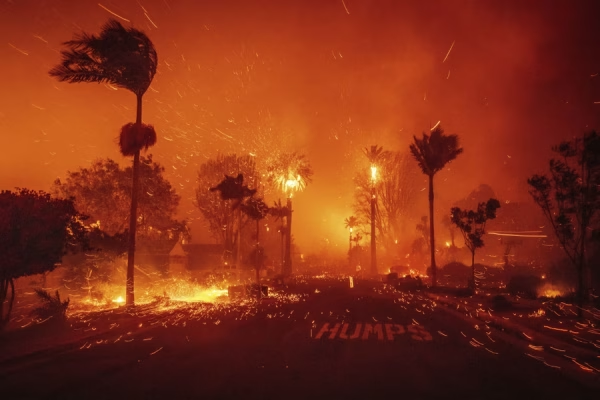The Palisades Fire in January may be causing cancer for the firefighters in Los Angeles. Researchers think the chemicals in the fire are causing this deadly sickness.
The Palisades Fire ranks as the second most destructive wildfire in Southern California history, causing 23,000 acres and 5,000 structures burned. Wildland firefighters are regularly exposed to carcinogens, and at least two thirds of firefighters die from job related cancer, according to the International Association of Firefighters.
“If I saw the wildfires in California in person I would probably run as fast as I can away from there.” Eighth grader Mikaela Brooks said. “And I would also call the fire department.”

Seven feet away, a neighboring home was going up in flames. However, even with goggles on, the stuff in the smoke made it feel like sandpaper in Los Angeles Firefighter Joseph Field’s eyes. Unfortunately, the hose water only flowed for 2 feet before coming back at them. Despite this, the firefighters helped fight the fires for seven days in a row, went home for a day, and then came back for eight more days.
“I could not breathe, and I was trying to catch my breath and coughing,” Field said. “We’re not used to getting our butts kicked on a fire, This fire, for the most part, kicked all our butts.”
Field, along with 300 other firefighters are participating in a study to monitor their exposure to cancer-causing chemicals, due to the LA fires. Researchers with the Wildfire Conservancy and the University of Arizona collected urine and blood samples from these firefighters. On top of this, they’ve also collected contaminant absorbing wristbands the firefighters wore to measure their exposures.
“If I were a firefighter, I would let the researchers take my blood samples because I would be curious if I had chemicals in my body or not, and what they would do to me,” seventh grader Angelica Brooks said. “I would also not continue my job if I knew I had chemicals in my body, because I wouldn’t want more chemicals in my body than I already had.”
The first set of results from the ongoing investigation found that 42 firefighters who were fighting the LA fires had higher amounts of chemicals called PFAS (PFAS or Per- and polyfluoroalkyl substances are a large, complex group of synthetic chemicals that have been used in consumer products and industrial processes since the 1950s.) in their blood. The researchers are not sure whether these changes will be linked to health problems. However, an analysis of heavy metal exposures shows higher levels of key metals, such as cobalt, arsenic, and chromium.
“If I had chemicals in my body, I would probably think they would cause cancer or some other sickness,” seventh grader Olivia Adams said. “And having chemicals in my body probably wouldn’t be good for me anyway, so I would definitely be worried.”
According to a 2024 study by US Forest Service researchers; Wildland firefighters are regularly exposed to carcinogens, and at least 29 have been linked to this type of fire. However, the firefighters that battle fires in urban areas are exposed to even more hazardous emissions from the burning of natural and human-made fuels.
Wildland firefighters are regularly exposed to carcinogens, and at least 29 have been linked to this type of fire. However, the firefighters that battle fires in urban areas are exposed to even more hazardous emissions from the burning of natural and human-made fuels.
“I think firefighters should wear protective gear because it’s pretty obvious; they need gear,” seventh grader Janell Randle said. “Most firefighters die from the smoke rather than the things failing on them so yeah they need gear that protects them from chemicals.”